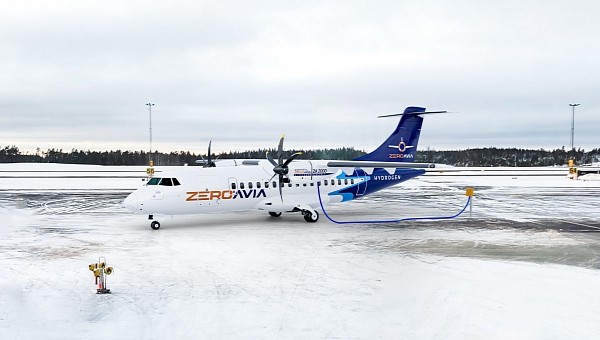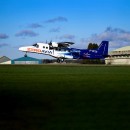ZeroAvia is mostly known for developing hydrogen-electric powertrains that could someday power a new generation of airliners. The adequate infrastructure is just as important, and this will be the main focus of a new European partnership.
ZeroAvia’s ultimate goal is to have an 80-seat airliner running exclusively on hydrogen. This is set to happen just a few years from now, before the end of this decade. Until then, the UK-based aviation company is doing things gradually. It started with the ZA600 powertrain, developed for 9-to-19 passenger aircraft, and a 300-mile (485 km) range, and working its way up to the ZA2000.
A 19-seat Dornier 228 aircraft, retrofitted with ZeroAvia’s 600 kW powertrain, made history in ten minutes. The historic flight took place in January, at the Cotswold Airport in Gloucestershire, UK. That’s where the company’s main development hub is located.
It was part of a government-backed project, called HyFlyer II, with the goal of developing a commercially-available hydrogen propulsion system for aircraft. The ZA600 is set to become fully certified by next year.
In the meantime, ZeroAvia is also working on hydrogen infrastructure, and that’s not just for aircraft.
Hydrogen could be used for all on-ground operations at airports, as well. Airports around the world have already started to replace conventional vehicles with battery-electric or hybrid alternatives. But ZeroAvia has an even more ambitious vision, where airports would become hydrogen hubs, using this alternative source of power for all operations, both in the sky and on the ground.
It looks like Northern Europe is one of the first areas where this vision could come to life. Fortum, a Nordic energy company, has joined forces with ZeroAvia, in order to set up a network for hydrogen production and refueling across the region.
In addition to the ZA600, the aviation startup has also developed and successfully tested something called HARE (Hydrogen Airport Refueling Ecosystem) claiming to be the first of its kind globally.
In 2022, ZeroAvia unveiled this innovative landside-to-airside pipeline, at Cotswold Airport. The 100-meter-long (328 feet) pipeline was a key component of the company’s infrastructure system, together with an electrolyzer and a mobile refueling station.
ZeroAvia has also established facilities in Hollister, California, with Shell as its main partner. Shell was the one who designed and built two commercial-scale mobile refueling units for the California facility. This is where a second Dornier-228 testbed aircraft was retrofitted for upcoming test flights. ZEV Station is another important partner for ZeroAvia’s plan of developing hydrogen hubs across California.
Back in Europe, the hydrogen startup has already secured partnerships with two airports, Rotterdam The Hague (the Netherlands) and Birmingham (UK), for implementing HARE. Hydrogen-powered demonstration flights at these locations are coming up in 2024.
A 19-seat Dornier 228 aircraft, retrofitted with ZeroAvia’s 600 kW powertrain, made history in ten minutes. The historic flight took place in January, at the Cotswold Airport in Gloucestershire, UK. That’s where the company’s main development hub is located.
It was part of a government-backed project, called HyFlyer II, with the goal of developing a commercially-available hydrogen propulsion system for aircraft. The ZA600 is set to become fully certified by next year.
In the meantime, ZeroAvia is also working on hydrogen infrastructure, and that’s not just for aircraft.
Hydrogen could be used for all on-ground operations at airports, as well. Airports around the world have already started to replace conventional vehicles with battery-electric or hybrid alternatives. But ZeroAvia has an even more ambitious vision, where airports would become hydrogen hubs, using this alternative source of power for all operations, both in the sky and on the ground.
It looks like Northern Europe is one of the first areas where this vision could come to life. Fortum, a Nordic energy company, has joined forces with ZeroAvia, in order to set up a network for hydrogen production and refueling across the region.
In addition to the ZA600, the aviation startup has also developed and successfully tested something called HARE (Hydrogen Airport Refueling Ecosystem) claiming to be the first of its kind globally.
In 2022, ZeroAvia unveiled this innovative landside-to-airside pipeline, at Cotswold Airport. The 100-meter-long (328 feet) pipeline was a key component of the company’s infrastructure system, together with an electrolyzer and a mobile refueling station.
ZeroAvia has also established facilities in Hollister, California, with Shell as its main partner. Shell was the one who designed and built two commercial-scale mobile refueling units for the California facility. This is where a second Dornier-228 testbed aircraft was retrofitted for upcoming test flights. ZEV Station is another important partner for ZeroAvia’s plan of developing hydrogen hubs across California.
Back in Europe, the hydrogen startup has already secured partnerships with two airports, Rotterdam The Hague (the Netherlands) and Birmingham (UK), for implementing HARE. Hydrogen-powered demonstration flights at these locations are coming up in 2024.







